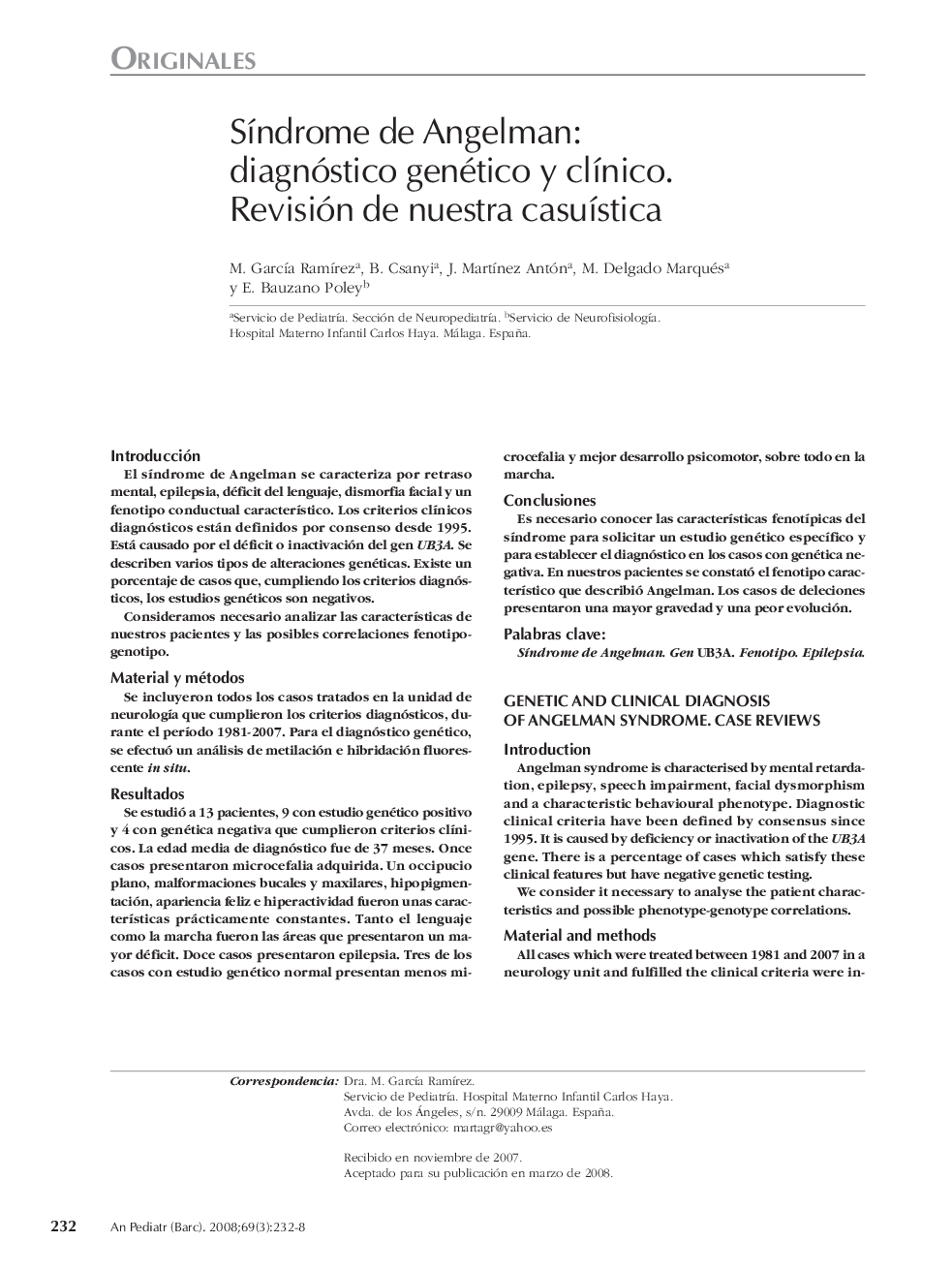| کد مقاله | کد نشریه | سال انتشار | مقاله انگلیسی | نسخه تمام متن |
|---|---|---|---|---|
| 4143524 | 1272410 | 2008 | 7 صفحه PDF | دانلود رایگان |

IntroducciónEl síndrome de Angelman se caracteriza por retraso mental, epilepsia, déficit del lenguaje, dismorfia facial y un fenotipo conductual característico. Los criterios clínicos diagnósticos están definidos por consenso desde 1995. Está causado por el déficit o inactivación del gen UB3A. Se describen varios tipos de alteraciones genéticas. Existe un porcentaje de casos que, cumpliendo los criterios diagnósticos, los estudios genéticos son negativos.Consideramos necesario analizar las características de nuestros pacientes y las posibles correlaciones fenotipo-genotipo.Material y métodosSe incluyeron todos los casos tratados en la unidad de neurología que cumplieron los criterios diagnósticos, durante el período 1981-2007. Para el diagnóstico genético, se efectuó un análisis de metilación e hibridación fluorescente in situ.ResultadosSe estudió a 13 pacientes, 9 con estudio genético positivo y 4 con genética negativa que cumplieron criterios clínicos. La edad media de diagnóstico fue de 37 meses. Once casos presentaron microcefalia adquirida. Un occipucio plano, malformaciones bucales y maxilares, hipopigmentación, apariencia feliz e hiperactividad fueron unas características prácticamente constantes. Tanto el lenguaje como la marcha fueron las áreas que presentaron un mayor déficit. Doce casos presentaron epilepsia. Tres de los casos con estudio genético normal presentan menos microcefalia y mejor desarrollo psicomotor, sobre todo en la marcha.ConclusionesEs necesario conocer las características fenotípicas del síndrome para solicitar un estudio genético específico y para establecer el diagnóstico en los casos con genética negativa. En nuestros pacientes se constató el fenotipo característico que describió Angelman. Los casos de deleciones presentaron una mayor gravedad y una peor evolución.
IntroductionAngelman syndrome is characterised by mental retardation, epilepsy, speech impairment, facial dysmorphism and a characteristic behavioural phenotype. Diagnostic clinical criteria have been defined by consensus since 1995. It is caused by deficiency or inactivation of the UB3A gene. There is a percentage of cases which satisfy these clinical features but have negative genetic testing.We consider it necessary to analyse the patient characteristics and possible phenotypegenotype correlations.Material and methodsAll cases which were treated between 1981 and 2007 in a neurology unit and fulfilled the clinical criteria were included. Genetic diagnosis was made by methylation testing and fluorescent in situ hybridization.ResultsThirteen patients were studied, nine with positive genetic testing and four with negative testing who completed the clinical criteria. The average age at diagnosis was 37 months. Eleven cases showed acquired microcephaly. Flat occiput, mouth and maxillary malformations, hypopigmentation, a happy appearance and hyperactivity were practically constant characteristics. Speech and walking ability were the areas which showed most deficit. Twelve cases had epilepsy. Three of the cases with normal genetic testing showed less microcephaly and better psychomotor development, particularly in walking ability.ConclusionsThe phenotypical characteristics of the syndrome should be known before requesting specific genetic testing and to make a diagnosis even in cases with negative genetic. The phenotype characteristics that describe Angelman syndrome were verified. Deletion cases had a worse outcome.
Journal: Anales de Pediatría - Volume 69, Issue 3, September 2008, Pages 232–238